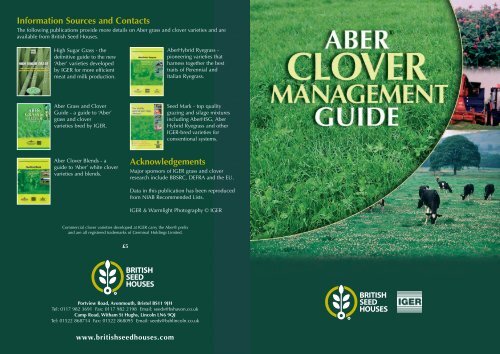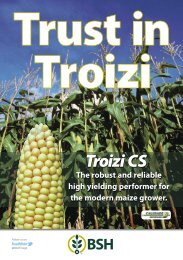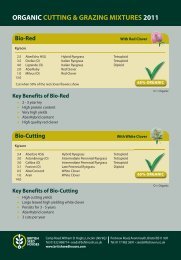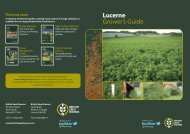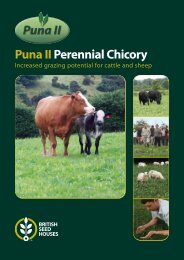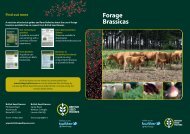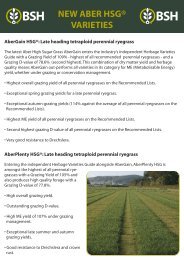Create successful ePaper yourself
Turn your PDF publications into a flip-book with our unique Google optimized e-Paper software.
Information Sources and Contacts<br />
The following publications provide more details on <strong>Aber</strong> grass and clover varieties and are<br />
available from British Seed Houses.<br />
High Sugar Grass - the<br />
definitive guide to the new<br />
‘<strong>Aber</strong>’ varieties developed<br />
by IGER for more efficient<br />
meat and milk production.<br />
<strong>Aber</strong>Hybrid Ryegrass -<br />
pioneering varieties that<br />
harness together the best<br />
traits of Perennial and<br />
Italian Ryegrass.<br />
<strong>Aber</strong> Grass and <strong>Clover</strong><br />
Guide - a guide to ‘<strong>Aber</strong>’<br />
grass and clover<br />
varieties bred by IGER.<br />
Seed Mark - top quality<br />
grazing and silage mixtures<br />
including <strong>Aber</strong>HSG, <strong>Aber</strong><br />
Hybrid Ryegrass and other<br />
IGER-bred varieties for<br />
conventional systems.<br />
<strong>Aber</strong> <strong>Clover</strong> Blends - a<br />
guide to ‘<strong>Aber</strong>’ white clover<br />
varieties and blends.<br />
Acknowledgements<br />
Major sponsors of IGER grass and clover<br />
research include BBSRC, DEFRA and the EU.<br />
Data in this publication has been reproduced<br />
from NIAB Recommended Lists.<br />
IGER & Warmlight Photography © IGER<br />
Commercial clover varieties developed at IGER carry the <strong>Aber</strong>® prefix<br />
and are all registered trademarks of Germinal Holdings Limited.<br />
£5<br />
Portview Road, Avonmouth, Bristol BS11 9JH<br />
Tel: 0117 982 3691 Fax: 0117 982 2198 Email: seeds@bshavon.co.uk<br />
Camp Road, Witham St Hughs, Lincoln LN6 9QJ<br />
Tel: 01522 868714 Fax: 01522 868095 Email: seeds@bshlincoln.co.uk<br />
www.britishseedhouses.com
Contents<br />
3. The developing role of clovers in UK livestock production<br />
4. Understanding white clover<br />
8. Managing white clover<br />
13. Understanding red clover<br />
15. Managing red clover<br />
19. Forging an effective combination<br />
20. <strong>Aber</strong> white clover variety guide<br />
22. Developments in red clover breeding<br />
The Developing Role of <strong>Clover</strong>s in<br />
UK Livestock Production<br />
Modern varieties of white and red clover offering higher yields, greater<br />
persistency, increased versatility and reliability are challenging outmoded<br />
perceptions of these crops and providing the impetus for a<br />
growing role in sustainable livestock systems.<br />
No longer are these crops only relevant and economically attractive<br />
in low input/low output systems and for organic production. Instead,<br />
they are increasingly important within progressive forage-based<br />
enterprises, independent of intensity of production, as cost effective providers of high quality home<br />
grown protein that also help reduce reliance on fertiliser nitrogen. As farming adapts to a new<br />
regime following CAP reform, so clovers will become even more important across the full spectrum<br />
of livestock systems.<br />
Long-standing white clover development programmes at IGER, and a more recent resurgence in<br />
work on red clover, are underpinning this increased interest and uptake.<br />
<strong>White</strong> clover has sometimes been seen as an inconsistent performer, but new varieties bred at<br />
IGER are now achieving optimum targets of a 30-35% contribution to total sward dry matter under<br />
a range of both grazing and conservation management systems. This is just one of the results of<br />
breeding work that has focussed on the key factors affecting white clover performance such as<br />
winter hardiness, pest and disease resistance and nitrogen tolerance. Compatibility with modern<br />
<strong>Aber</strong> ryegrass varieties is another important dimension, and is also a strength of IGER’s breeding<br />
programmes.<br />
Red clover breeding work recommenced at IGER in 1998 and is already producing new varieties<br />
such as <strong>Aber</strong>Ruby that are considerably better suited to the current requirements of UK livestock<br />
farming than their predecessors.<br />
Red clover is increasingly being grown both as a stand-alone crop and as a companion species<br />
to modern grasses, primarily for high quality silage and also for grazing. Breeding objectives include<br />
a focus on sustaining yields into a third year and beyond, enhanced grazing tolerance, and<br />
improved pest/disease resistance.<br />
A close affinity with agricultural practice remains a strong feature of IGER’s work. Selection and<br />
testing takes into account performance in the silo and in the rumen, as well as in the field under<br />
appropriate conditions (e.g. cattle and/or sheep grazing for white clover, conservation cuts and<br />
aftermath grazing for red clover). This co-ordinated approach, and IGER’s on-going commitment to<br />
breeding, is geared to ensuring that white and red clover continue to make a significant contribution<br />
to the UK’s changing livestock farming industry for many years to come.<br />
<strong>Clover</strong> breeding at IGER is building on the agronomic platform described above and also helping<br />
to reduce the environmental impact of livestock agriculture, whilst enhancing the quality of the<br />
meat and milk produced.<br />
Dr Michael Abberton Head of <strong>Clover</strong> Breeding, IGER<br />
2 3
Understanding <strong>White</strong> <strong>Clover</strong><br />
Understanding <strong>White</strong> <strong>Clover</strong><br />
The Plant<br />
<strong>White</strong> clover is a perennial herbage<br />
legume. The key to its survival and<br />
production potential is the stolon<br />
(multi-branched creeping stem), as this<br />
provides the sites for new leaves,<br />
roots and flowers. The stolon is a<br />
store for carbohydrates and proteins,<br />
and provides the ability for the plant<br />
to over-winter and regenerate in the<br />
spring. Varieties of clover vary in their<br />
leaf and stolon characteristics, and it<br />
is these often quite marked<br />
differences that help to<br />
determine agronomic<br />
performance.<br />
Usage<br />
Flowerhead<br />
Stolon<br />
Full<br />
trifoliate<br />
leaf<br />
Nodule<br />
Fine roots<br />
Young<br />
trifoliate<br />
leaf<br />
Stolon<br />
growing<br />
point<br />
Intake – Ruminant livestock may consume 20-30% more white clover than grass, assuming<br />
equal access.<br />
Feed Value – Response per unit of feed intake is greater for white clover than it is for grass.<br />
This higher nutritive value is due to a lower proportion of structural fibre, higher protein<br />
content, and more of certain key minerals than grass (see table below).<br />
Typical quality characteristics of white clover and perennial ryegrass<br />
<strong>White</strong> clover Perennial ryegrass<br />
Digestibility (D value %) 75 - 82 65-75<br />
Crude protein (%) 27 17<br />
Dry matter intake by sheep (kg/day) 1.9 1.4<br />
Calcium content (%) 1.6 0.6<br />
Magnesium content (%) 0.18 0.16<br />
Phosphorus (%) 0.6 0.3<br />
Copper (parts per million) 10.0 6.5<br />
Selenium (parts per 100 million) 0.6 0.2<br />
<strong>White</strong> clover is almost<br />
universally grown with a companion grass, and most typically with ryegrass, with the type of<br />
ryegrass being dependent upon the primary use of the sward.<br />
Developments in white clover breeding have increased the versatility of its use and the<br />
longevity of white clover within swards, with greater nitrogen tolerance being a key feature<br />
in more intensive systems. Sustainable systems incorporating white clover range from long<br />
term leys for continuous sheep grazing (using small leaved white clover varieties) through to<br />
medium term leys for rotational sheep or cattle grazing (modern medium leaf varieties), and<br />
short term cutting and cattle grazing leys (large leaf varieties).<br />
Key Benefits of <strong>White</strong> <strong>Clover</strong><br />
Nitrogen Fixation – Rhizobium bacteria, which exist symbiotically within protuberances or<br />
‘nodules’ on clover roots, convert nitrogen from the air into a form that can be utilised by the<br />
plant; this process is called nitrogen fixation. This nitrogen becomes available for companion<br />
grasses and/or subsequent crops as it is released following plant decay or from the dung and<br />
urine of grazing livestock.<br />
It is estimated that the utilisable nitrogen generated through the fixation process is equivalent<br />
to 100–150 kgN/ha in a well-balanced and stable grass and clover sward.<br />
<strong>White</strong> clover has the added advantage of retaining high digestibility throughout the season,<br />
as there is continual renewal of leaves and petioles and relatively little stem development.<br />
Soil Structure – <strong>White</strong> clover root systems improve soil structure and can help to overcome<br />
problems of soil compaction.<br />
Studies at IGER have demonstrated<br />
improved soil structure resulting from a<br />
greater white clover component in the<br />
sward:<br />
• <strong>White</strong> clover has been shown to<br />
significantly decrease the bulk density<br />
of soils and increase porosity.<br />
• Fertiliser recovery from soils with<br />
improved structure due to white clover<br />
was shown to increase from less than<br />
50% to over 75%.<br />
• General movement of nutrients was<br />
improved, with the result that more<br />
grass was produced.<br />
Improved soil structure is seen in the soil core with a<br />
higher clover content (right)<br />
4 5
Understanding <strong>White</strong> <strong>Clover</strong><br />
<strong>Clover</strong> Dominance<br />
The proportion of clover in a grass/clover sward is commonly over-estimated, typically by<br />
twofold. The images below should be used as a guide to achieving the optimum balance as<br />
described later.<br />
If clover does become dominant (i.e. when very little grass is visible), then it can outcompete<br />
the grass component and unbalance the sward. This may lead to increased weed<br />
ingression and greater vulnerability of the clover to winter damage. This is most common in<br />
the second and thirds years of a ley, and a more desirable grass/clover balance will be seen<br />
in the third year and beyond.<br />
If clover dominance is a problem:<br />
• avoid regular silage cutting sequences, as the regular removal of nitrogen will<br />
encourage more clover;<br />
• consider using smaller leaved clover varieties in future;<br />
• more intensive grazing, particularly by sheep, will suppress the clover;<br />
• tactical application of nitrogen.<br />
Understanding <strong>White</strong> <strong>Clover</strong><br />
Sward Composition<br />
Maintaining an optimum dry matter balance of 30% white clover to 70% grass as an average<br />
across the season is the key to grass/clover sward management, as this is expected to provide<br />
best exploitation of the clover’s nutritional and nitrogen fixing attributes alongside high<br />
yielding grass.<br />
In the past, white clover growth patterns and the nature of the interaction with grass have<br />
tended to cause significant seasonal variation of clover content in swards – from as little as<br />
5% in the spring up to 60% in summer – but clover breeding work at IGER is producing<br />
varieties that are more compatible with modern ryegrasses and have more even seasonal<br />
growth curves.<br />
Bloat Awareness<br />
Bloat is the excessive build up of gas (carbon dioxide and methane) in the rumen resulting in<br />
distress and possible death due to the exertion of pressure on the animal’s diaphragm, heart<br />
and lungs. Some legumes, including white clover because of the rapid breakdown of protein<br />
in the rumen, present an increased risk of bloat if the correct management is not applied.<br />
Effective management procedures to minimise or eliminate the risks of bloat in livestock<br />
grazing clover-dense swards should include:<br />
• Limiting access to swards when stock are first introduced;<br />
• Feeding high dry matter forage such as hay/straw prior to turnout;<br />
• Offering hay/straw at intervals (e.g. to dairy cows at milking times);<br />
• Feeding an anti-bloat feed additive.<br />
5 - 15% 16 - 30%<br />
31 - 50% 50% plus<br />
6 7
Managing <strong>White</strong> <strong>Clover</strong><br />
Successful Establishment<br />
Targets<br />
The aim at establishment should be to achieve a minimum of 150 clover seedlings per square<br />
metre within a mixed white clover/grass sward.<br />
Techniques<br />
In a rotational situation, preceding crops should ideally be cereals, roots or brassicas, which<br />
lead to reduced nitrogen levels in the soil and encourage clover establishment.<br />
Broadcasting is the most reliable method of establishing a clover-based sward, and is<br />
generally considered more successful than drilling.<br />
Undersowing to a cereal crop is an alternative, particularly if the cereal is to be harvested<br />
early (July) for wholecrop. If undersowing grain crops, cereal varieties should be early<br />
maturing and lodging resistant, and cereal seed rate should not exceed 140kg/ha.<br />
<strong>White</strong> clover can be introduced into an existing sward (see Sward Renovation).<br />
Timing<br />
April – mid-August is the optimum sowing period on most UK farms. Seedlings must have<br />
begun producing stolons before the onset of winter.<br />
Seedbed<br />
A clean seedbed is essential, and this should ideally be ring rolled<br />
prior to sowing. Optimum soil pH is 6.0 – 6.5. Liming to correct pH<br />
should be carried out well in advance of sowing.<br />
Fertiliser nitrogen should only be applied in low N status soils, up to<br />
50kgN/ha. Phosphate (P 2 O 5 ) and potash (K 2 O) is required at<br />
application rates of 50 – 120 kg/ha, depending on soil indices.<br />
Managing <strong>White</strong> <strong>Clover</strong><br />
The most common disease affecting white clover is clover rot (Sclerotinia), which causes a<br />
generalised rot of the plant (see page 16).<br />
It is important to be aware of the risks of both pests and diseases and take the appropriate<br />
action, including selection of new stem nematode resistant <strong>Aber</strong> varieties (where available)<br />
and use of agrochemicals following advice from a qualified agronomist.<br />
In the case of damage from both pests and disease, the mobility of white clover resulting<br />
from stolon extension allows rapid re-colonisation by surviving (and possibly resistant) plants,<br />
thereby reducing the impact of infestation.<br />
Weed Control<br />
First and foremost, a clean seedbed is essential in order to avoid competition from weed<br />
species during establishment.<br />
Most annual and some perennial weeds can be controlled by regular pasture topping, but it<br />
may be necessary to use herbicides in some circumstances, in which case ensure a cloversafe<br />
product is used and only spray if clover plants are vigorous and well developed.<br />
Pelleted Seed<br />
Techniques of white clover seed pelleting have been developed at IGER as a means of<br />
improving establishment especially in areas where white clover has not been previously<br />
grown.<br />
Features and benefits of white clover seed pelleting<br />
Features<br />
Benefits<br />
Seed Rate and Sowing Depth<br />
Seeds mixtures should contain between 2 and 4kg/ha of white<br />
clover seed depending upon environmental conditions to achieve<br />
target establishment and an optimum balance in the sward.<br />
Optimum seed depth is 5 – 10mm.<br />
Combating Pests and Diseases<br />
The main pests affecting white clover during establishment are:<br />
Sitona weevil - leaf damage<br />
Increased<br />
seed size<br />
Phosphate<br />
fertiliser<br />
Lime<br />
Improved seed placement<br />
in the seedbed<br />
Promotes root growth<br />
Reduces competition for nutrients<br />
Neutral micro-environment to<br />
aid root development<br />
• Slugs; potentially devastating in problem areas.<br />
• Stem eelworm; causes distortion of growing buds and young<br />
leaves and death of the plant.<br />
• Sitona weevil; more common close to arable areas and leads<br />
to the removal of small semi-circular sections of leaflets.<br />
• Leatherjackets; more common following the ploughing of old<br />
pastures.<br />
Stem eelworm damage<br />
Pesticide<br />
Rhizobium<br />
inoculants<br />
Protection against pests such<br />
as Sitona weevil<br />
Rapid nodulation by efficient<br />
nitrogen fixing strains<br />
8 9
Managing <strong>White</strong> <strong>Clover</strong><br />
Two stage establishment<br />
Effective control of annual and perennial weeds in new<br />
sown leys has become more difficult due to the<br />
withdrawal of some key products in recent years.<br />
Particular difficulties occur in relation to clover, so new<br />
approaches are required to ensure the establishment of<br />
weed free grass and clover swards.<br />
One such method is to establish a weed free grass ley in<br />
advance of introducing clover, using a two-stage system.<br />
Following an existing ley with perennial weed problems (docks, thistles etc.)<br />
1. For autumn reseeds start the control of perennial weeds in the preceding spring, with<br />
root acting chemistry that has good activity on the weeds e.g. Doxstar (Docks), Thistlex<br />
(Thistles), Pastor (Docks, Thistles, Nettles).<br />
For spring reseeds start weed control in the previous season.<br />
These products are not clover safe.<br />
2. Use glyphosate (3-6 litres/ha) to “burn off” old ley and any surviving weeds.<br />
3. Sow new ley mix (excluding clover).<br />
4. Monitor ley during establishment. Treat weed problems if necessary from 3 true leaves<br />
of the grass onwards. Non clover safe options give broader more effective weed<br />
control. E.g. Doxstar at 1.5 litres/ha in 200 litres water (chickweed, seedling docks);<br />
Pastor at 2.0 litres/ha in 200 litres water (broad spectrum).<br />
5. Stitch clover into established sward (April – August) having allowed minimum of 6<br />
weeks following use of non clover safe materials (see Sward Renovation on p.12).<br />
Following arable crops/maize or weed free swards<br />
1. Use glyhosate at 1.5-4.0 litres/ha (arable stubbles) or at 3-6 litres/ha (grass swards) to<br />
“burn off” old ley and any weeds.<br />
2. Repeat steps 3- 5.<br />
For further advice telephone The Dow AgroSciences Hotline on 0800 6898899<br />
ALWAYS READ THE LABEL USE PESTICIDE SAFELY<br />
Pastor, Thistlex, Doxstar are trademarks of Dow AgroSciences LLC.<br />
Doxstar contains triclopyr and fluroxypyr. Pastor contains clopyralid, fluroxypyr and triclopyr. Thistlex contains<br />
clopyralid and triclopyr<br />
Managing <strong>White</strong> <strong>Clover</strong><br />
Systems in practice<br />
Grazing management of <strong>White</strong> <strong>Clover</strong><br />
• Observe size and vigour of stolons in the spring in order to determine optimum<br />
management strategy<br />
• Ensure the appropriate variety is grown for intensive grazing<br />
• Avoid excessive stolon damage through poaching<br />
• Use intensive grazing, particularly by sheep, as a brake on clover content, or less<br />
frequent cutting to increase clover content<br />
• Keep grass at 4-6 cm over winter to protect stolons from frost damage<br />
• Choose suitable companion grasses and the best clover varieties of appropriate leaf size<br />
for the system<br />
Continuous Grazing<br />
• Use smaller leaved varieties to withstand hard grazing pressure<br />
• Modern varieties grown with compatible companion grasses in long term leys can sustain<br />
high dry matter yields for the duration of the ley, assuming low nitrogen fertiliser inputs<br />
Rotational Sheep Grazing<br />
• Modern medium leaved varieties are most suitable<br />
• Consider inclusion of small leaved varieties where grazing pressure is heavy<br />
• Swards with 30% white clover content can be maintained for at least 10 years, with<br />
total sward dry matter yields of 10 –11 t/ha/annum<br />
• The use of modern nitrogen tolerant <strong>Aber</strong> varieties enables high clover content swards<br />
to be maintained with nitrogen ferilizer levels up to 200 kgN/ha/annum.<br />
Annual P & K requirements of white or red clover / grass leys (kg/ha)*<br />
Soil P or K Index 0 1 2 3 4<br />
Grazing<br />
P 60 40 20 0 0<br />
K 60 30 0 0 0<br />
Silage(3 Cut)<br />
P 130 105 80 20 0<br />
K 340 290 250 90 0<br />
*Some of the P and K can be supplied in manures/slurry. Eg 40 m 3 /ha dairy cow slurry may supply 48 kg/ha P and 140 kg/ha K.<br />
10<br />
11
Managing <strong>White</strong> <strong>Clover</strong><br />
Rotational Cattle Grazing<br />
• Modern medium leaved varieties grown with compatible companion grasses can<br />
provide a total sward dry matter yield of 11 – 13 t/ha/annum.<br />
• Longevity of the sward is determined by the companion grasses, with perennial<br />
ryegrass offering up to 8 years, hybrid ryegrass up to 5 years, and Italian ryegrass 2 – 3<br />
years duration.<br />
• Modern nitrogen tolerant varieties perform well in swards receiving up to 350<br />
kgN/ha/annum.<br />
• Where swards are cut frequently (for silage) it is beneficial to include a proportion of<br />
the white clover content as large leaved varieties.<br />
Sward Renovation<br />
<strong>White</strong> clover can be introduced to an existing sward through a variety of methods, from slot<br />
seeding to broadcasting following scarification. Greatest success will be achieved by<br />
observing the following principles:<br />
• Minimise competition from existing plants prior to sowing by heavy grazing and/or<br />
harrowing to open up the sward.<br />
• Observe normal sowing timings (April –August) and soil nutrient/pH status parameters.<br />
• Take advantage of the period when grass is least vigorous (after flowering in July) if<br />
there is sufficient soil moisture, particularly after a silage cut.<br />
Understanding Red <strong>Clover</strong><br />
The Plant<br />
Red clover is a short-lived perennial<br />
herbage legume that typically persists<br />
for 2 – 4 years. In contrast to white<br />
clover, it has a upright growth form and<br />
a strong deep tap root from which finer<br />
roots arise. The crown, located at the base of<br />
the stem, acts as a store of nutrients. Differences<br />
in the size and reserve status of the crown affect<br />
persistency and suitability for particular<br />
management regimes.<br />
Usage<br />
Red clover is often grown as part of a<br />
grass/clover sward, but can also be grown as a<br />
monoculture, primarily to provide high yields of<br />
protein rich forage for conservation. The<br />
development of more grazing tolerant and persistent<br />
varieties is creating the potential for red clover in rotational<br />
grazing systems, and it also has value as a break crop that<br />
improves soil structure and fertility.<br />
Cutting and Grazing Heights<br />
Leaflets<br />
Petiole<br />
Crown<br />
Tap root<br />
• Ensure soil is sufficiently disturbed to allow seed contact and coverage (5-10mm seed<br />
depth).<br />
• Use a higher seed rate (4kg/ha) than conventional sowing to compensate for greater<br />
seedling loss. Lower seed rates (from 2.5 kg/ha) may be used for a periodic top-up in<br />
long term swards.<br />
• Use pelleted seed to improve establishment, where necessary.<br />
• Use slug pellets as an established sward may well harbour this pest.<br />
• Graze lightly and in short periods until clover is well established.<br />
<strong>White</strong> <strong>Clover</strong> Blends<br />
Blending complementary varieties of white clover, with a range of leaf sizes, offers significant<br />
advantages over growing single varieties, particularly in varying environmental and<br />
management situations.<br />
As the crown is above ground, damage must be avoided to ensure<br />
plant survival:<br />
• Cutting height for all silage cuts should be 7-8 cm;<br />
• Optimum grazing height of aftermaths or over winter is 4-6 cm;<br />
• In wet weather, avoid heavy machinery, and limit grazing to sheep.<br />
Key Benefits of Red <strong>Clover</strong><br />
Nitrogen Fixation - Rhizobium bacteria exist symbiotically within red clover root nodules<br />
and produce available nitrogen, the same as white clover and other legumes.<br />
High yields – Red clover swards are typically capable of producing 10-15 tonnes DM/ha<br />
annually.<br />
Feed Value – Protein content is particularly high in red clover, and – due to a form of<br />
biochemical protection – there is a reduction in protein loss in the silo. Feed value is greater<br />
than it appears on analyses due to the composition of the protein.<br />
12 13
Understanding Red <strong>Clover</strong><br />
Break Cropping – Red clover has significant benefits as a break crop in mixed farming<br />
situations due to its ability to improve soil structure and soil nutrient status.<br />
Monoculture or Companion Grass<br />
Red clover is primarily grown in a<br />
mixed sward, but can also be grown as<br />
a monoculture. Italian, hybrid and<br />
perennial ryegrasses, and Timothy, are<br />
possible companion grasses.<br />
Advantages of growing red clover with<br />
a companion grass:<br />
• reduced impact of poaching<br />
• improved nutritional balance<br />
(from <strong>Aber</strong> High Sugar Grass)<br />
• utilisation of fixed nitrogen by<br />
grass<br />
Hybrid ryegrass and intermediate heading perennial ryegrass at 20-24 kg/ha with red<br />
clover at 7.5 kg/ha has been shown to be an effective 3-4 year ley mixture providing<br />
high yields of quality silage followed by late season lamb grazing.<br />
Italian ryegrass is most useful as a companion species in predominantly arable rotations<br />
where a 2 year ley is preferred.<br />
Bloat Awareness<br />
Red clover presents similar risks of bloat to white clover.<br />
Management procedures to minimise or eliminate the risks of bloat are the same as for white<br />
clover.<br />
Oestrogenic Content<br />
Red clover typically contains high levels of phyto-oestrogens, particularly formononetin,<br />
which can cause a reduction in ovulation rates in ewes. It is therefore advisable to avoid<br />
grazing red clover varieties with ewes six weeks before and six weeks after tupping.<br />
New red clover varieties with low levels of formononetin are being developed, offering the<br />
potential for greater flexibility in the use of this crop for sheep farmers.<br />
Managing Red <strong>Clover</strong><br />
Successful Establishment<br />
Targets<br />
The aim when establishing a red clover ley is<br />
to achieve 200 plants per square metre by<br />
October in the sowing year.<br />
Techniques<br />
Red clover can be drilled or broadcast, and<br />
can be undersown to an arable silage crop in<br />
April. It can be introduced into an existing<br />
sward (see Sward Renovation on page 18).<br />
Timing<br />
April – late July is the optimum sowing<br />
period on most UK farms.<br />
Seedbed<br />
A fine, firm seedbed is essential, and this<br />
should ideally be ring rolled prior to sowing.<br />
Soil pH should be 6.0 or above. Liming to<br />
correct pH should be carried out well in<br />
advance of sowing.<br />
Fertiliser nitrogen should only be applied in<br />
low N status soils, up to 50kgN/ha.<br />
Phosphate (P 2 O 5 ) and potash (K 2 O) is<br />
required at application rates of 50 – 120<br />
kg/ha, to achieve soil indices of 2+.<br />
For full data on P and K requirements see<br />
page 11.<br />
Seed Rate and Sowing Depth<br />
Monoculture swards should be sown at<br />
15kg/ha.<br />
Seed rate for mixed swards should be<br />
7kg/ha red clover and 22kg/ha of Italian<br />
or hybrid ryegrass.<br />
Optimum seed depth is 5 – 10mm, and<br />
should never exceed 15mm.<br />
The height of a red clover sward should not go lower<br />
than 4-5 cm when grazed in order to avoid damage to<br />
the crown (inset)<br />
14 15
Managing Red <strong>Clover</strong><br />
Managing Red <strong>Clover</strong><br />
Systems in practice<br />
Conservation<br />
• Graze swards lightly in the autumn of the sowing year.<br />
• Four cuts at 6-8 week intervals yielding 13-14 tonnesDM/ha on fertile sites (10<br />
tonnesDM/ha on upland sites).<br />
• Ensile at 25 – 30% DM to minimise wilting losses.<br />
• Avoid crown damage caused by low cutting height.<br />
• Graze autumn re-growth lightly to finish lambs or cattle.<br />
• No nitrogen, 100-150 kg/ha K 2 O, 200-300 kg/ha P 2 O 5 .<br />
• 3-4 years good yields achievable with modern varieties.<br />
<strong>Clover</strong> rot (Sclerotinia) is the most common disease affecting both red and white clover (pictured) and is<br />
characterised by a general rot of the plant<br />
Combating Pests and Diseases<br />
<strong>Clover</strong> rot (Sclerotinia) is the most important disease affecting red clover. This fungal disease,<br />
seen typically in December/January, causes a generalised rot of the crown, leaves and stems<br />
from which plants rarely recover. <strong>Clover</strong> rot cannot usually be controlled safely or<br />
economically in situ and hence a 5 – 7 year rotation is strongly recommended.<br />
Stem eelworm is the most important pest affecting red clover and the most effective control is<br />
rotation. A five year break is recommended between red clover crops, and this should be<br />
extended to seven years if stem eelworm is known to be present.<br />
Crown and root rot (typically caused by Fusarium) and powdery mildew also affect red<br />
clover, but are less devastating.<br />
Agrochemicals for the prevention of pest and disease problems should only be used<br />
following advice from a qualified agronomist.<br />
Weed Control<br />
Adopt the same weed control measures as for white clover (see page 9)<br />
Typical analysis of red clover/ryegrass silage<br />
Metabolisable Energy<br />
9.8 – 11.4 MJ/kg DM<br />
Crude Protein 14 – 19%<br />
pH 4.0 – 4.5<br />
Ammonia Nitrogen<br />
< 5% of total nitrogen<br />
16 17
Managing Red <strong>Clover</strong><br />
Forging an Effective Combination<br />
Lamb performance from grazed red clover or ryegrass<br />
Red <strong>Clover</strong><br />
Grazing<br />
• Aftermath grazing for sheep.<br />
• Superior lamb growth rates from red clover compared with ryegrass.<br />
• Grazing in wet or moist conditions must be avoided to limit bloat and reduce<br />
poaching.<br />
Organic<br />
• Key conservation crop for organic livestock farms.<br />
• Typically undersown to spring barley.<br />
• Valuable break crop that improves soil nutrient status and soil structure.<br />
Sward Renovation<br />
• Potential for upgrading existing swards due to large seed and vigorous seedlings.<br />
• Cost effective improvement of soil fertility and soil structure.<br />
• Apply similar principles as for white clover.<br />
• See Bronydd Mawr data on page 23.<br />
Ryegrass<br />
Growth rate (g/day) 229 182<br />
Days to finish 40 49<br />
Eye muscle depth (mm) 27.1 25.9<br />
Subcutaneous fat depth (mm) 4.1 3.9<br />
Cold carcass weight (kg) 18.8 17.7<br />
Killing out percentage (%) 51 48<br />
Source: Institute of Grassland and Environmental Research<br />
The benefits of combining grass and clover<br />
in swards for both grazing and conservation<br />
are long established and well proven.<br />
The most important benefits can be<br />
summarised as:<br />
• improved forage quality and feed<br />
value due to a boost in digestibility,<br />
intake potential, and protein and<br />
mineral content of the sward<br />
• reduced reliance on fertiliser due to<br />
nitrogen fixation<br />
• “soil structuring” by white clover root<br />
systems that can help to overcome<br />
problems of soil compaction<br />
Liveweight Gains on <strong>Clover</strong> (Beef Cattle)<br />
% <strong>Clover</strong> Gain (g/d)<br />
1200<br />
1000<br />
800<br />
600<br />
400<br />
200<br />
0<br />
Source: IGER<br />
60<br />
50<br />
40<br />
30<br />
20<br />
10<br />
0<br />
Grazing<br />
Conserved<br />
Grass Grass/ Grass/<br />
<strong>White</strong> <strong>Clover</strong> Red <strong>Clover</strong><br />
Evidence of persistence of modern white<br />
clover varieties (<strong>Aber</strong>Dai)<br />
•<br />
•<br />
•<br />
•<br />
• •<br />
•<br />
•<br />
• • • •<br />
•<br />
•<br />
N150 KgN/ha<br />
N0<br />
1 2 3 4 5 6 7 8<br />
Years<br />
Source: IGER<br />
Accumulated experience and scientific<br />
evidence indicate that the optimum balance is<br />
achieved with a clover content of 30-35% of<br />
the total annual dry matter yield of the sward.<br />
In reality, the clover content of a mixed<br />
sward will vary from a low level in the spring<br />
(as low as 5% of total dry matter) to as high as<br />
60% in July/August. This level of variability in<br />
the clover content is not ideal from the<br />
perspective of managing the feeding value for<br />
livestock and can also cause deterioration in<br />
sward quality over time. Hence, greater<br />
compatibility between grass and white clover<br />
varieties is vital in order for livestock farmers<br />
to gain maximum benefit.<br />
Breeding for compatibility<br />
A compatible grass/clover mixture is one with a<br />
clover content that is sufficiently large to<br />
optimize the nutritional and nitrogen fixing<br />
attributes of the clover when growing with a<br />
high yielding companion grass.<br />
Grass and clover varieties differ in their<br />
aggressiveness towards each other due to their<br />
abilities to compete for nutrients, water and<br />
light. At IGER, breeding for general<br />
compatibility is high on the agenda and<br />
varieties are routinely tested for this attribute.<br />
Evidence of the progress that takes clover<br />
into a new era of utilisation is summarised by<br />
three key areas:<br />
• Annual clover contributions of 30% or<br />
greater from IGER-bred varieties have<br />
been proven experimentally and are<br />
now being seen on the farm<br />
• Compatibility with modern <strong>Aber</strong> Italian,<br />
<strong>Aber</strong>Hybrid and high yielding <strong>Aber</strong><br />
perennial ryegrass varieties<br />
• Evidence from long-term experiments<br />
showing effective levels of clover<br />
being maintained in swards for many<br />
years under high and low N regimes<br />
18<br />
19
<strong>Aber</strong> <strong>White</strong> <strong>Clover</strong>s: Small Leaved Varieties<br />
<strong>Aber</strong>Ace<br />
This new variety has the smallest leaf size of any on the recommended lists and was bred<br />
specifically for continuous sheep grazing in lowland and upland conditions. It has an<br />
exceptionally dense network of stolons and will persist well under the most rigorous of sheep<br />
grazing systems.<br />
<strong>Aber</strong>Crest<br />
Productive under sheep grazing as well as under rotational grazing by dairy cows.<br />
Bred from wild populations collected in Switzerland, <strong>Aber</strong>Crest’s major attribute is its good cold<br />
hardiness and stolon survival. It possesses a thick stolon compared with other<br />
small leaved varieties and shows more rapid regrowth following cutting or grazing in spring.<br />
<strong>Aber</strong>Pearl<br />
A new small leaved variety combining exceptional ground cover under hard grazing and with<br />
high annual yield. Bred from a gene pool of varieties showing exceptional spring growth, this<br />
variety is ideal where livestock farmers wish to maintain a healthy balance between grass and<br />
clover throughout the year. Growth characteristics allow grass to compete with the clover in mid<br />
summer, but its persistence gives good clover content in the spring and autumn.<br />
Spring Ground Cover Rating<br />
9<br />
8<br />
7<br />
6<br />
5<br />
<strong>Aber</strong>Ace Kent S184 Gwenda <strong>Aber</strong>Pearl G Demand Crusader<br />
Source: NIAB R.L. 2005/06<br />
1= poor 9= good<br />
<strong>Aber</strong> <strong>White</strong> <strong>Clover</strong>s: Medium Leaved Varieties<br />
<strong>Aber</strong>Herald<br />
With a relatively small leaf size, this variety is high yielding and has excellent winter survival<br />
combined with the ability to regrow rapidly in spring. <strong>Aber</strong>Herald is also tolerant of nitrogen,<br />
and has been maintained in swards at 25% with inputs of 380kgN/ha. This variety is suitable<br />
for rotational sheep and cattle grazing systems, and can also be cut for silage.<br />
<strong>Aber</strong>Dai<br />
This variety was bred from winter hardy material to provide flexibility in response to various<br />
management regimes. It offers high yields and survives well in systems ranging from<br />
continuous sheep grazing to rotational grazing by cattle or sheep.<br />
<strong>Aber</strong>Concord<br />
A new medium leaved variety producing yields as great as some large leaved clovers and<br />
gives good performance over a wide range of N inputs (0-450kg/ha). This trait contributes to<br />
a stable clover yield over several years by allowing clover to tolerate the build-up of nitrogen<br />
in the soil. <strong>Aber</strong>Concord also provides good winter survival and spring growth, regrowing<br />
rapidly following cutting and grazing, and is suitable for a range of management systems,<br />
from rotational grazing by sheep and cattle to conservation.<br />
Relative DM Yield (3rd Harvest Year)<br />
150<br />
125<br />
100<br />
75<br />
Alberta G Bounty Avoca <strong>Aber</strong>Herald <strong>Aber</strong>Concord *Menna<br />
Source: NIAB R.L. 2005/06<br />
(*Yield of Menna = 3.18 t/DMha)<br />
<strong>Aber</strong>Ace Stolon Density<br />
Annual DM Yield (150kgN/ha/yr)<br />
Response to Grazing Management<br />
Stolon Density m/m 2<br />
400<br />
350<br />
300<br />
250<br />
200<br />
150<br />
100<br />
50<br />
0<br />
<strong>Aber</strong>Ace KWW S184 Demand<br />
Source: IGER, Bronydd Mawr<br />
<strong>White</strong> clover varieties being assessed for persistence by<br />
sheep at IGER<br />
DM Yield T/ha<br />
7<br />
6<br />
5<br />
4<br />
3<br />
2<br />
1<br />
0<br />
Source: IGER<br />
<strong>Aber</strong>Concord<br />
Menna<br />
Annual Dry Matter Yield (t/ha/annum)<br />
Continuous<br />
sheep Cutting<br />
grazing<br />
Olwen (large) 2.0 7.5<br />
Menna (medium) 3.7 5.1<br />
<strong>Aber</strong>Dai (medium) 4.1 6.9<br />
Source: IGER<br />
20<br />
21
Red <strong>Clover</strong> Development<br />
The re-emergence of red clover<br />
Growing interest in safe, traceable homegrown protein - together with the continuing<br />
development of organic farming systems – has resulted in significantly greater demand for<br />
red clover in recent years. This situation is likely to continue in the era after CAP reform as<br />
livestock farmers seek greater returns from homegrown feed.<br />
This resurgence in the crop is being underpinned by the recommencement of red clover<br />
breeding at IGER after an interval of 15 years. A new DEFRA-funded programme began in<br />
1998 and the first new variety – <strong>Aber</strong>Ruby – features in official recommended lists in 2005.<br />
Red clover breeding objectives<br />
The main objectives of IGER’s red clover breeding programme are:<br />
• Greater overall persistency.<br />
• Higher yields, particularly in the third year and beyond.<br />
• Enhanced grazing tolerance, to allow greater flexibility in use (e.g. aftermath grazing).<br />
• Improved resistance to pests and diseases, with emphasis on stem nematode (eelworm)<br />
and clover rot (Sclerotinia).<br />
• Improved nutritional quality to enhance protein utilisation and reduce nitrogenous<br />
losses.<br />
• Lower oestrogen content to reduce the potentially deleterious affects on ewe fertility.<br />
Red clover in the uplands<br />
Studies at IGER’s Bronydd Mawr research farm<br />
on the edge of the Brecon Beacons indicate<br />
that red clover could have great potential on<br />
upland farms. Good yields have been obtained<br />
for up to five years from overseeding on<br />
upland pastures.<br />
The increased persistence seen at upland sites<br />
is thought to be due to two particular features:<br />
• Development of the crown closer to or<br />
beneath the soil surface, when compared<br />
with growth in the lowlands, which gives<br />
the plant greater stability and less<br />
vulnerability to cutting and grazing.<br />
• Lower burden of pests and diseases than in<br />
lowland situations.<br />
Red <strong>Clover</strong> Development<br />
The Bronydd Mawr study has included work on overseeding establishment methods, which<br />
showed a yield benefit for direct drilling in the first two years. Yield differential between<br />
direct drilling and alternative methods (broadcast and scarify/broadcast) lessened in later<br />
years. In this study, <strong>Aber</strong>Ruby red clover was sown into a three year old hybrid ryegrass ley.<br />
Red <strong>Clover</strong> Establishment at Bronydd Mawr (Year 1 and Year 2 mean, <strong>Aber</strong>Ruby)<br />
Annual herbage<br />
t/ha<br />
<strong>Aber</strong> Red <strong>Clover</strong>s<br />
<strong>Aber</strong>Ruby<br />
The first of a new generation of red clover varieties released from IGER. <strong>Aber</strong>Ruby out<br />
performs all the other varieties on the NIAB list, achieving a record yield of 115% in year<br />
one and 111% overall. <strong>Aber</strong>Ruby is a broad leaved early diploid variety.<br />
Red <strong>Clover</strong> Yield NIAB List 2005/6<br />
110<br />
105<br />
100<br />
95<br />
90<br />
<strong>Aber</strong>Ruby *Merviot Mercury Lemon Amos T<br />
Source: NIAB D.L. 2005/06<br />
(*Yield of Merviot = 13.23 t/DMha)<br />
% of Merviot<br />
8<br />
6<br />
4<br />
2<br />
0<br />
Source: IGER, Bronydd Mawr<br />
Broadcast Broadcast + Direct Control<br />
Scarification<br />
Drilling<br />
New varieties currently being assessed<br />
A range of new red clover varieties with comparable yield to <strong>Aber</strong>Ruby is now emerging<br />
from the IGER breeding programme.<br />
These will offer advantages as outlined in the breeding objectives, including low oestrogens,<br />
resistance to key diseases, increased persistency, grazing tolerance and yield.<br />
22 23


